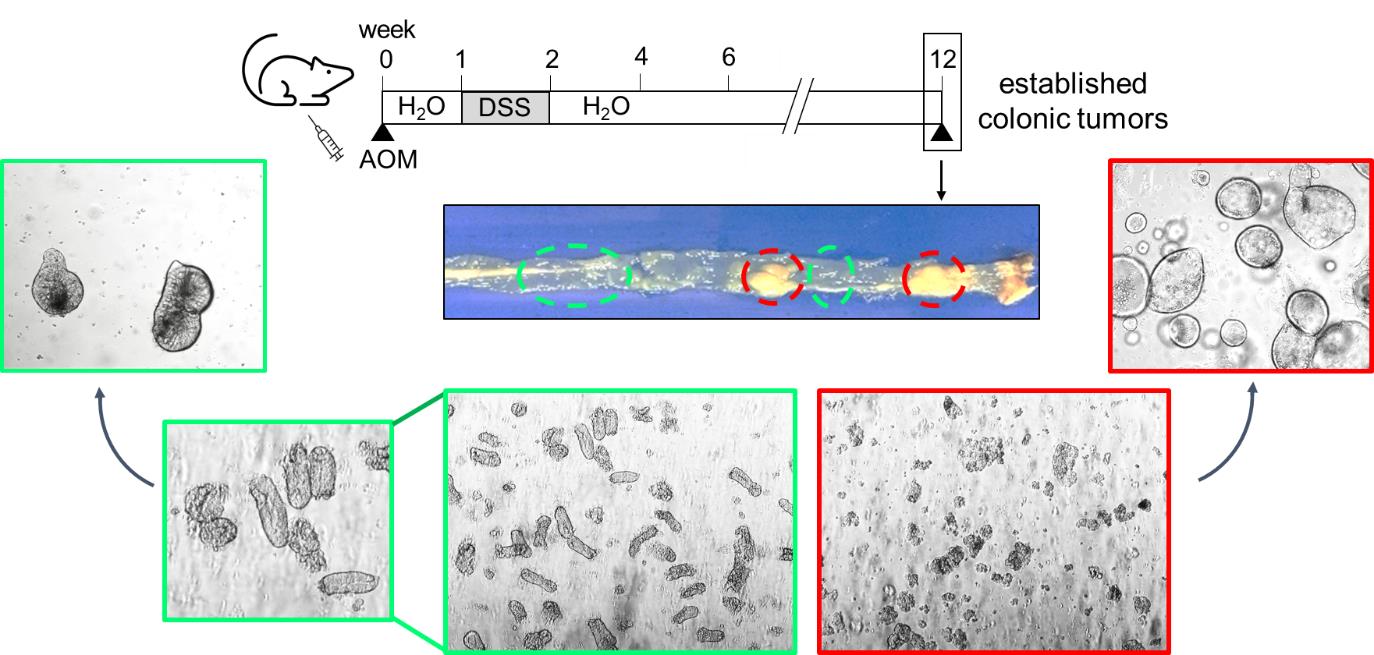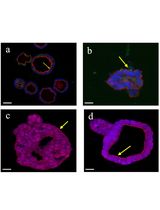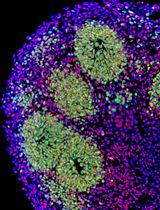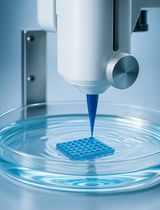- 提交稿件
- 订阅
- CN
- EN - English
- CN - 中文
- EN - English
- CN - 中文
Preparation and Cultivation of Colonic and Small Intestinal Murine Organoids Including Analysis of Gene Expression and Organoid Viability
小鼠结肠和小肠类器官的制备和培养,包括基因表达和类器官活力的分析
(*contributed equally to this work) 发布: 2022年01月20日第12卷第2期 DOI: 10.21769/BioProtoc.4298 浏览次数: 5645
评审: Takashi NishinaSalah Boudjadi
Abstract
Organoids are complex three-dimensional structures, which contain different cell types and help to overcome many limitations of conventional 2D cell culture techniques. Here, we present a protocol for the cultivation of murine matched-pairs of small intestinal and colonic epithelial organoids, and colonic tumor organoids derived from the chemical colorectal cancer (CRC) AOM/DSS mouse model. Therefore, intestinal crypts or tumor tissue containing stem cells are isolated from the same donor mouse and cultivated in Matrigel®. The culture medium is supplemented with different growth factors to model the intestinal stem cell niche, allowing their self-renewal and differentiation. Matched-pair organoids enable the analysis of pharmacological effects and the tumor selectivity of drugs.
Graphic abstract:

Schematic overview of colonic matched pair organoid preparation, generated from the chemical AOM/DSS colorectal cancer mouse model. Please note that normal colon-derived organoids (green) differ in their morphology from tumor-derived organoids (red). Normal colonic-derived organoids display a thicker and crypt-like epithelial layer, whereas tumor-derived organoids are round with a thin epithelial layer.
Background
Organoids are three dimensional structures, which are derived from pluripotent stem cells or organ restricted stem cells. They have the ability for self-organization and differentiation, mirroring key functional and structural properties of the respective organ (Clevers, 2016). Over the past decades, organoid culture became an important model in the fields of personalized and targeted therapies as well as for the prediction of drug responses (Lancaster and Knoblich, 2014; Clevers, 2016). Hence, organoids have become indispensable for many fields of biomedical and translational research (Wallach and Bayrer, 2017; Fair et al., 2018; Almeqdadi et al., 2019).
In the context of colorectal cancer (CRC), we provide a protocol to generate murine matched-pair organoids, to evaluate the cytotoxicity and tumor selectivity of certain cancer drugs.
Intestinal organoids were first established by Sato et al. (2009) from small intestinal stem cells for long-term culture in a collagen matrix. The technique was then further developed by the same research group, enabling organoid cultures from normal epithelium and tumor tissue from the colon (Sato et al., 2011).
Based on previously published protocols for intestinal organoids (O’Rourke et al., 2016; https://www.stemcell.com/technical-resources/intestinal-epithelial-organoid-culture-with-intesticult-organoid-growth-medium-mouse-lp.htmL), we summarize our modified step-by-step protocol for the generation of murine matched pair organoids. In contrast to previous protocols, we used three different cell lines to generate Wnt3a, Noggin, and Rspondin-1 conditioned medium. These components are essential for proper self-renewal and proliferation of the stem cell pool. Furthermore, we provide detailed protocols for further analysis of drug-treated organoids, such as RNA and protein isolation, morphological quantification, membrane permeability staining using propidium iodide/ Hoechst 33342, and an ATP-based cell viability assay (CellTiter-Glo® 3D).
Materials and Reagents
6 well clear TC-treated multiple well plates (Costar, catalog number: 3516)
12 well clear TC-treated multiple well plates (Greiner, catalog number: 665180)
24 well clear TC-treated multiple well plates (Corning, catalog number: 353504)
96 well black/clear flat bottom TC-treated imaging microplate with Lid (Corning, catalog number: 353219)
150 mL bottle top vacuum filter, 0.22 µm pore (Corning, catalog number: 431161)
Cannulas, Braun, Sterican® Gr. 18, G 26 x 1""/ ø 0.45 x 25 mm
Cell culture flasks, 550 mL, 175 cm2 (Greiner, catalog number: 660175)
Cell strainer Nylon mesh 100 µm (BD Biosciences, catalog number: 352360)
Cover glasses (Merck, catalog number: C9802-1PAK)
Cryotube vials 1.8 mL (Thermo Scientific, catalog number: 377267PK)
Oral gavage needle (GLOMED Inc., catalog number: AFN2038S)
Cutting board or styrofoam board
Petri dish (Sarstedt, catalog number: 82.1472.001)
Pipette tip, 10 µL (Sarstedt, catalog number: 70.1130.600)
Pipette tip, 200 µL (Sarstedt, catalog number: 70.760.502)
Pipette tip, 1,000 µL (Heinemann, catalog number: PSB)
Portable Pipet-Aid® XP (Drummond, catalog number: 4-000-201)
Serological pipette, plugged, 10 mL (Sarstedt, catalog number: 86.1254.025)
Sterile single use bottle top filters (Thermo Scientific, catalog number: 596-4520)
Surgical blades (Swann Morton, catalog number: 0206)
Transfer pipette (Sarstedt, catalog number: 86.1171.010)
Tube, 50 mL (Labsolute, catalog number: 7696705)
Razor blades (Fisher Scientific, catalog number: 12-640)
Reaction vials, 1.5 mL (Roth, catalog number: 7080.1)
Reaction vials, 2 mL (Roth, catalog number: 7083.1)
Cultrex HA-R-Spondin1-Fc 293T Cells (R&D Sytems, catalog number: 3710-001-01)
HEK293T mWnt3a cells (kindly provided by Robyn Laura Kosinsky)
HEK293T mNoggin cells (kindly provided by Tiago De Oliveira; published in Farin et al., 2012)
A83-01 (Merck Millipore, Sigma-Aldrich, catalog number: SML0788)
Adenosine 5′-triphosphate disodium salt hydrate (ATP, Sigma-Aldrich, catalog number: A2383-1G)
Advanced DMEM/F-12 (Thermo Fisher Scientific, Gibco, catalog number: 12634010)
Azoxymethane (AOM, Sigma-Aldrich, catalog number: A5486)
Dextran sodium sulfate (MP Biomedicals, catalog number: 160110)
B-27TM supplement (Thermo Fisher Scientific, Gibco, catalog number: 17504044)
BCA protein assay (Pierce, catalog number: 23227)
Bovine serum albumin (Roth, catalog number: 8076.3)
Cell recovery solution (Corning, catalog number: 354253)
CellTiter-Glo® 3D cell viability assay (Promega, catalog number: G9682)
CHIR 99021 (Axon Medchem, catalog number: 1386)
Collagenase type I (Gibco, catalog number: 17018)
cOmpleteTM mini protease inhibitor cocktail (Roche, catalog number: 11836170001)
DMEM, high glucose, GlutaMAXTM (Thermo Fisher Scientific, Gibco, catalog number: 10566016)
DMSO (AppliChem, catalog number: A3672,0100)
Dual-Glo® Luciferase Assay System (Promega, catalog number: E2920)
M50 Super 8× TOPFlash (Addgene, catalog number: 12456)
M51 Super 8× FOPFlash (TOPFlash mutant) (Addgene, catalog number: 12457)
pRL-TK vector (Promega, catalog number: E2241)
EDTA (Roth, catalog number: 8040.3)
Ethanol (Roth, catalog number: 8388.3)
Fetal bovine serum (Anprotec, catalog number: AC-SM-0190)
GeneticinTM, G418 (InvivoGen, catalog number: ant-gn-1)
GlutaMAXTM supplement (Thermo Fisher Scientific, Gibco, catalog number: 35050061)
Goat anti-Human IgG (H+L) Secondary Antibody, HRP (Invitrogen, catalog number: 31410)
HEPES (Thermo Fisher Scientific, Gibco, catalog number: 15630080)
Hoechst 33342 Trihydrochloride Trihydrate (Invitrogen, catalog number: H3570)
Hydrochloric acid 25% (Merck, catalog number: 1003122500)
Imidazole (Roth, catalog number: 3899.2)
Immobilon Western Chemiluminescent HRP Substrate (ECL) (Merck Millipore, catalog number: WBKLS0500)
L-Glutamine (Gibco, catalog number: 25030123)
LipofectamineTM 3000 Transfection Reagent (Invitrogen, catalog number: L3000015)
Matrigel® Matrix GFR (Corning, catalog number: 354230)
N-2 supplement (Thermo Fisher Scientific, Gibco, catalog number: 17502048)
N-Acetyl-L-Cysteine (Merck Millipore, Sigma-Aldrich, catalog number: A9165)
Nicotinamid (Merck Millipore, Sigma-Aldrich, catalog number: N3376)
Nitrocellulose membrane (Merck, catalog number: GE10600001)
Powdered milk (Roth, catalog number: T145.4)
Normal mouse IgG1 (Santa Cruz, catalog number: SC-3877)
InVivoMAb human IgG1 isotype control (bxcell, catalog number: BE0297)
Peroxidase AffiniPure F(ab')2 Fragment Donkey Anti-Mouse IgG (H+L) (Jackson ImmunoResearch, catalog number: 715-036-150)
Paclitaxel (Sigma-Aldrich, catalog number: T7191)
PBS tablets (Gibco, catalog number: 18912014)
Penicillin-streptomycin (Gibco, catalog number: 15140122)
Propidium iodide solution (Sigma-Aldrich, catalog number: P4864-10ML)
rmEGF (Immunotools, catalog number: 12343407)
ROCK inhibitor Y-27632 (Merck Millipore, Sigma-Aldrich, catalog number: SCM075)
Sodium chloride (Roth, catalog number: 3957.2)
Sodium deoxycholate (Sigma-Aldrich, catalog number: 30970)
Sodium fluoride (Applichem, catalog number: A0401)
Sodium orthovanadate (Sigma-Aldrich, catalog number: S6508)
Sodium pyruvate (Thermo Fisher Scientific, Gibco, catalog number: 11360070)
Tris-HCl (Roth, catalog number: 4855.3)
TritonTM X-100 (AppliChem, catalog number: A1388)
TRIzolTM Reagent (Invitrogen, catalog number: 15596026)
Trypsin-EDTA (0.05%) (Gibco, catalog number: 25300096)
TrypLETM Express Enzyme (1X) (Thermo Fisher Scientific, catalog number: 12604013)
Tween® 20 (AppliChem, catalog number: A4974)
ZeocinTM (InvivoGen, catalog number: ant-zn-05)
TBS-T buffer (see Recipes)
RIPA buffer (see Recipes)
HEK293T Noggin cell culture medium (see Recipes)
HEK293T Rspondin-1 cell culture medium (see Recipes)
HEK293T Wnt3a cell culture medium (see Recipes)
Ad+ medium (see Recipes)
Colon normal and tumor organoid culture medium (see Recipes)
Small intestinal organoid culture medium (see Recipes)
Equipment
Forceps (Carl Roth™)
Micropipettes (Eppendorf)
Multichannel pipette (Eppendorf)
Surgical scissors (Braun, catalog number: 64069805)
Axiovert 40 CFL Microscope (Carl ZeissTM, model: 491202-0002-001)
Celigo S Imaging Cytometer (Nexcelom Bioscience)
Centro LB 960 Luminometer (Berthold Technologies, model: 38100-50)
HERAcell 150 Incubator (Heraeus, model: 2854)
Megafuge 1.0R Centrifuge (Heraeus, model: 75003060)
Thermomixer Comfort (Eppendorf, model: 5355 000.011)
Software
AxioVision 4.8.2 (Carl Zeiss MicroImaging GmbH)
Celigo 4 Channel Software Version 5.0.0.0 (Nexcelom Bioscience)
Fiji or ImageJ (http://fiji.sc/ or https://imagej.nih.gov/ij/)
GraphPad Prism 5, Version 5.04 (Graphpad Software Inc.)
Microsoft 365 (Microsoft)
MikroWin 2000, Version 4.37 (Mikrotek Laborsysteme GmbH)
Procedure
文章信息
版权信息
© 2022 The Authors; exclusive licensee Bio-protocol LLC.
如何引用
Klemke, L., Blume, J. P., De Oliveira, T. and Schulz-Heddergott, R. (2022). Preparation and Cultivation of Colonic and Small Intestinal Murine Organoids Including Analysis of Gene Expression and Organoid Viability. Bio-protocol 12(2): e4298. DOI: 10.21769/BioProtoc.4298.
分类
癌症生物学 > 侵袭和转移 > 癌症治疗
细胞生物学 > 基于细胞的分析方法
细胞生物学 > 细胞分离和培养 > 3D细胞培养
您对这篇实验方法有问题吗?
在此处发布您的问题,我们将邀请本文作者来回答。同时,我们会将您的问题发布到Bio-protocol Exchange,以便寻求社区成员的帮助。
提问指南
+ 问题描述
写下详细的问题描述,包括所有有助于他人回答您问题的信息(例如实验过程、条件和相关图像等)。
Share
Bluesky
X
Copy link













